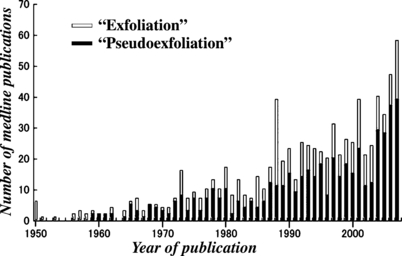Trends in the usage of the synonymous terms ‘pseudoexfoliation’ and ‘exfoliation’ in the ophthalmological literature
Editor,
In 1917, the Finnish ophthalmologist John G. Lindberg first characterized the flaky material of the lens, which came, for a time, to be known as a superficial exfoliation of the anterior lens capsule (Tarkkanen et al. 2002). In 1928, Busacca claimed that the material did not represent exfoliation but the deposition of an unknown substance on the lens capsule (Duke-Elder 1969). Nearly 30 years later, Dvornk-Theobald (1954), in line with Busacca’s view, recommended that a new term, ‘pseudoexfoliation’, be used to distinguish the condition from capsular delamination or true exfoliation. Over the past decade, a growing body of knowledge on the condition as a common age-related disorder of the extracellular matrix has facilitated an increase in our understanding of the clinicohistopathological correlates between ocular complications, systemic pseudoexfoliative material deposition and the molecular genetic basis of the pathomechanism, and has improved clinical management through the recognition of earlier stages of the condition (Schlötzer-Schrehardt & Naumann 2006). However, the term ‘exfoliation’ has been used as equivalent to ‘pseudoexfoliation’. This letter reports the trends in usage of the synonyms in the current ophthalmic literature.
A search of journal article titles in the literature database PubMed, carried out in September 2008, using either ‘pseudoexfoliation (pseudoexfoliative)’, ‘exfoliation (exfoliative)’, or both, retrieved 3038 articles. Twelve articles described ‘true exfoliation of the lens capsule’ and 2216 articles used the term ‘exfoliation’ to describe exfoliative tissue changes or exfoliative cytology in medical disciplines outwith ophthalmology, including oncology, dermatology, gastroenterology and dentistry. The terms ‘pseudoexfoliation’ and ‘exfoliation’ were used in 495 and 315 articles in the field of ophthalmology, respectively, to describe the same ocular disorder and its complications, such as glaucoma.
The 495 articles that used the term ‘pseudoexfoliation’ included papers using the terms ‘pseudoexfoliation syndrome’ (n = 250), ‘pseudoexfoliation glaucoma’ (n = 98) and ‘pseudoexfoliation materials’ (n = 37). The 315 articles that used ‘exfoliation’ described ‘exfoliation syndrome’ (n = 199), ‘exfoliation glaucoma’ (n = 96) and ‘exfoliative materials’ (n = 16). Analyses of abstracts revealed that the two terms have identical meaning. There was a steady increase in the number of international publications concerning ocular pseudoexfoliation and exfoliation (Fig. 1). Noticeably, the ratio of use of ‘pseudoexfoliation’ to use of ‘exfoliation’ has remained constant during the past decades, except in the year 1988, when an international symposium on exfoliation syndrome was held.

Numbers of articles reporting ocular ‘exfoliation’ and ‘pseudoexfoliation’ by year of publication.
The majority of articles were published in ophthalmology journals. Most of them appeared in Acta Ophthalmologica Scandinavica (n = 168), which probably reflects a higher prevalence of the condition in northern Europe, followed by the British Journal of Ophthalmology (n = 53), American Journal of Ophthalmology (n = 45), Archives of Ophthalmology (n = 40), Ophthalmology (n = 39), Graefes Archive for Clinical and Experimental Ophthalmology (n = 36), Journal of Cataract and Refractive Surgery (n = 32) and Klinische Monatsblätter für Augenheilkunnde (n = 32). Original communications were provided in English (n = 632) and other languages (n = 178). The ratio of use of ‘pseudoexfoliation’ : ‘exfoliation’ was 1.46 in English-language articles and 2.07 in non-English articles; the difference was not statistically significant. It was significant that German and Romanian articles preferred the term ‘pseudoexfoliation’, whereas French and Japanese articles preferred the term ‘exfoliation’.
The search of the current literature demonstrates that the term ‘exfoliation’ is used not uncommonly as a synonym of ‘pseudoexfoliation’. There is no reason for the term ‘pseudoexfoliation’ to be replaced by ‘exfoliation’, even given recent advances in knowledge of the disorder (Schlötzer-Schrehardt & Naumann 2006). I suggest, therefore, that the classic term ‘pseudoexfoliation’ is preferable in descriptions of the characteristic ocular pathology.




